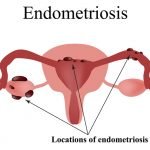Migraines are a horrible type of headache–not that any kind of headache is desirable. But tension and sinus headaches tend to bring on pain then go away; migraines, on the other hand, often produce nausea, visual disturbances, lightheadedness, and light sensitivity in addition to throbbing pain. Plus, they can linger for up to three days. But now, a step has been taken toward figuring out what may produce migraines in some people and hopefully bring us a little closer to their prevention. New research suggests that these headaches might have something to do with fats in the bloodstream.
The study, which was conducted at the Johns Hopkins University School of Medicine in Baltimore, Maryland, found that female migraine sufferers appear to have different levels of several lipids in their blood than their peers who do not have migraines.1 Peterlin, B. Lee; et al. “Interictal, circulating sphingolipids in women with episodic migraine.” Neurology. 9 September 2015. Accessed 16 September 2015. http://www.neurology.org/content/early/2015/09/09/WNL.0000000000002004 The subjects were 52 women who get migraines and 36 women who do not. All of the participants who experienced migraines were considered to have what’s known as episodic migraines, defined as migraines that occur up to 14 days a month. The average among this group was approximately six days of migraines per month.
Blood samples were drawn from all of the volunteers and analyzed to measure the levels of various lipids. Ceramides, a group of lipids found in cell membranes that help regulate the cells, were shown to typically be much lower in women with episodic migraines than they were among their headache-free counterparts. The subjects with migraines averaged approximately 6,000 nanograms per milliliter (ng/ml) of cermides, while those without migraines averaged approximately 10,500 ng/ml. In addition, the results determined that higher levels of two types of another lipid, sphingomyelin, increased a woman’s risk of having migraines as well. Sphingomyelin is a phospholipid often found in nervous tissue of the brain and spinal cord.
To test how accurately they could assess which of the participants had migraines solely based on the examination of the blood samples, the scientists randomly chose 14 of the samples with no knowledge of whether they belonged to a migraine sufferer or not. They were able to correctly categorize each sample by the levels of lipids present.
The study was not without certain shortcomings, however. The size of the participant sample included was extremely small so, therefore, cannot truly offer a representation of the population. It solely focused on women, a decision that may have been made because women are the majority of migraine patients, affected in 75 percent of the cases of the condition according to the Migraine Research Foundation. But excluding men limits the scope of the findings as we don’t know if the same results would be found for them. In addition, only people who have episodic migraines were asked to participate, which failed to take into consideration an entirely separate group who experience chronic migraines which occur more than 14 days per month.
Yet despite these faults, the investigation may prove to be quite helpful in diagnosing migraines. At the moment, doctors still base their diagnosis on a patient’s description of symptoms and family history of the condition. It also may improve our understanding of what causes migraines and how they can successfully be avoided or treated without pharmaceutical medication. The drugs commonly prescribed to combat migraines are triptans, which often plague users with nausea, muscle weakness, dizziness, and sleepiness; and ergotamines, which can cause side effects including increased nausea and vomiting as well as medication-overuse headaches.
The findings may not explain why people get migraines, but they do build on prior research suggesting a hormonal association. A 2009 study at the Institute of Clinical Pharmacology in Frankfurt, Germany showed that ceramides and sphingolipids are linked to breast cancer progression, particularly in estrogen receptor positive tumor tissues,2 Schiffmann, S.; et al. “Ceramide synthases and ceramide levels are increased in breast cancer tissue.” Carcinogenesis. May 2009. Accessed 17 September 2015. http://www.ncbi.nlm.nih.gov/pubmed/19279183 which suggests a hormonal effect that might explain why, if these same blood fats are involved in migraines, the headaches are so much more prevalent in women. On top of that, a 2009 study at Drexel University in Pennsylvania determined that extra belly fat may be a factor in the development of migraines, and belly fat is often the effect of excess estrogen. So if you experience migraines, you might want to shed some weight and use a natural hormone balancing formula. It might make enough of a difference to give you a migraine-free future.
References
| ↑1 | Peterlin, B. Lee; et al. “Interictal, circulating sphingolipids in women with episodic migraine.” Neurology. 9 September 2015. Accessed 16 September 2015. http://www.neurology.org/content/early/2015/09/09/WNL.0000000000002004 |
|---|---|
| ↑2 | Schiffmann, S.; et al. “Ceramide synthases and ceramide levels are increased in breast cancer tissue.” Carcinogenesis. May 2009. Accessed 17 September 2015. http://www.ncbi.nlm.nih.gov/pubmed/19279183 |












From the time I was about 18,
From the time I was about 18, I had migraines every month, sometimes twice a month, that would last 3 to 5 days. I was told these are called classic migraines as I would get visual disturbances that would take over my whole field of vision. That part would last for about 20 minutes. The next stage was a blindness that would last about 20 minutes… I could only see half of things. Then the nauseating pain would start. I would be given a drug that would knock me out for the majority of those days. About 10 years ago I was gene tested and found to be gluten intolerant. Once off gluten and dairy, I had no migraines for many many years. About two years ago, they returned … perhaps because I was going into menopause. I now get them a couple of times of year, and they usually come in triplets, one a day for 3 days. Thankfully, they’re only about half as painful as the ones I used to have. I no longer take drugs for these headaches but use celery juice and ice on the back of my neck. I also use acupressure to help alleviate the pain.